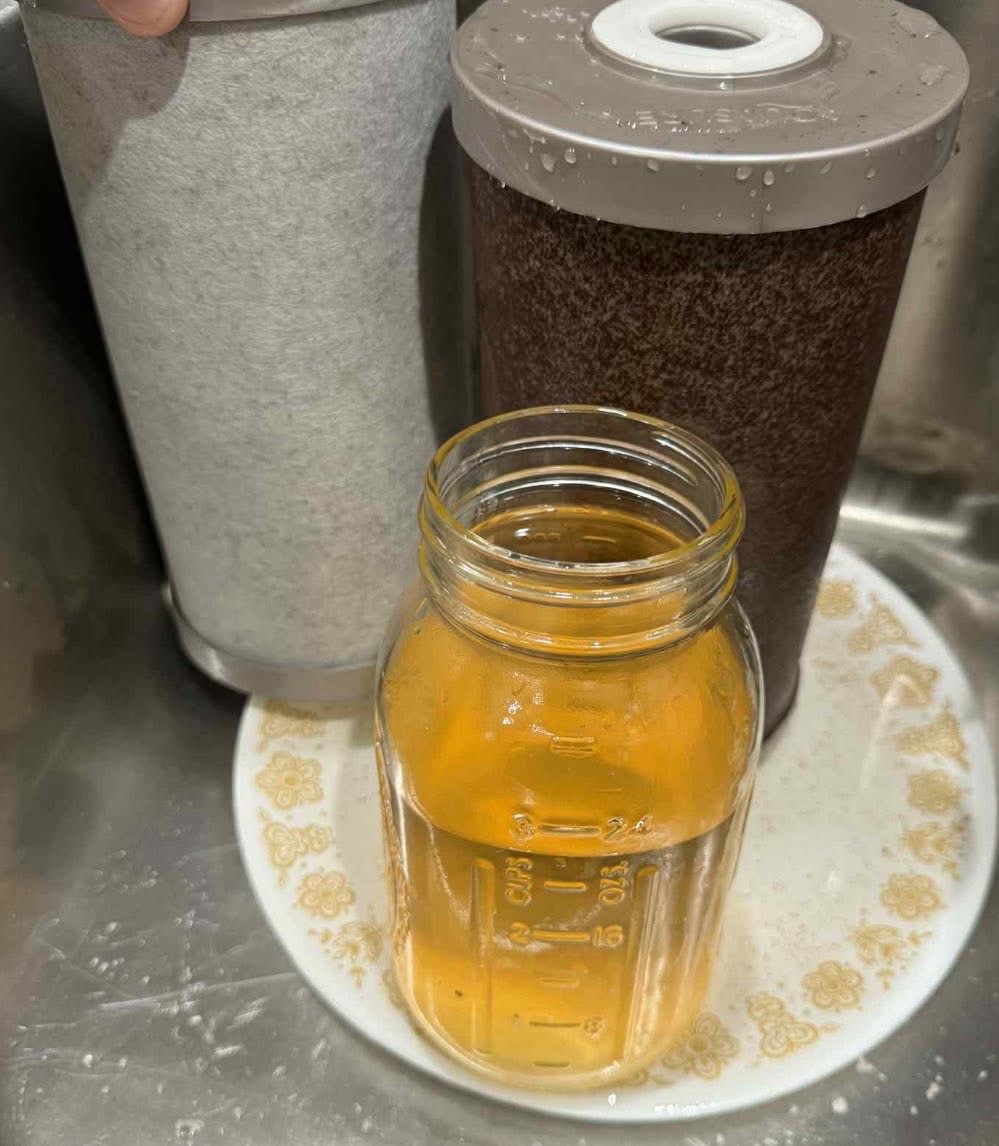Published for LiveInLapel.com • Updated: today
The short version
Lapel families continue reporting yellow/brown tap water, clogged filters, and foul smells. State and local officials say discoloration is often tied to iron/manganese and system disturbances, but residents want clearer answers and a concrete fix timeline. Wastewater (sewer) rates are proposed to rise ~40% over two years, with a key public meeting scheduled Nov. 20, 2025, 7:00 p.m., Lapel Lions Club. Bring questions and documentation (photos, dates, addresses).
What’s happening to our water?
Residents all over town have shared photos and samples showing tea-colored water that stains sinks and quickly loads up whole-house filters. (See the new vs. used filter images above.) Many families say they avoid drinking from the tap and are worried about bathing kids and pets.
This isn’t just a Lapel story anymore. The situation has attracted state and regional attention, including a detailed piece in The Brockovich Report highlighting ongoing discoloration reports in Lapel and similar concerns across Madison County. The article points to aging infrastructure, confusing communication, and rising costs shouldered by customers.
Statewide coverage from the Indianapolis Star and national syndication also note officials’ explanations (iron/manganese and flushing) alongside residents’ frustration with the persistence and severity of the discoloration.
Is discolored water “safe”?
According to the Indiana Department of Environmental Management (IDEM), discolored water can be caused by iron/manganese deposits stirred up by pressure changes, hydrant flushing, or operational issues (including incorrect chemical dosing). IDEM says discolored water “needs to be investigated,” and provides steps residents can take (running cold water, avoiding hot water use until clear, documenting events, and contacting the utility).
Important: Discoloration alone is not proof of a health violation, but IDEM emphasizes that systems must meet federal Safe Drinking Water Act standards and that events should be reported and addressed. If you’re seeing sudden changes, odors, grit, or persistent color, document it and notify the utility and IDEM.
Why are rates rising?
Separate from the color issue, wastewater (sewer) rates are slated for a substantial increase (about 40% over two years) tied to system improvements. A Nov. 20, 2025 public meeting is listed on the town website (Lions Club, 7 p.m.). Bring your questions about: project scope, milestones, financing, consumer protections, and how improvements will be measured.
Across Madison County, nearby Anderson is planning major water-system investments (about $130 million) and has discussed phased water rate increases to pay for bond costs—part of a broader regional pattern of aging infrastructure and rising utility bills.
What residents are asking for
From dozens of emails, posts, and meeting comments we’ve reviewed, Lapel residents are broadly aligned on a few goals:
Clear diagnostics: Source-of-discoloration analysis with public data (iron/manganese levels, turbidity, hydrant flushing schedules, treatment adjustments) in plain language. A repair plan with dates: What’s being fixed, when, who’s doing it, and how success will be measured (before/after sampling, color/turbidity targets). Rate transparency: How every dollar of proposed increases is allocated (engineering, pipes, pumps, treatment, contingency), and what performance milestones trigger releases of funds. Communication: A standing public dashboard (updated weekly) that shows complaints, sampling locations/results, and current work orders.
These requests mirror themes raised in outside reporting: aging pipes and treatment equipment, confusing or conflicting official statements, and households left to fend for themselves with filters and bottled water.
What you can do right now
1) Document problems.
Take timestamped photos/videos of discolored water, affected fixtures, and filters (inside/outside). Note date, time, and whether hydrant flushing or pressure changes were occurring nearby. Keep receipts for filters/bottled water.
2) Report it.
Contact the town/utility with your documentation, and also file with IDEM Drinking Water Branch (the agency that enforces the Safe Drinking Water Act in Indiana).
3) Show up and speak up.
Public Meeting: Nov. 20, 2025 at 7:00 p.m., Lapel Lions Club. Ask for the investigation summary, sampling results, and the sewer-rate project plan with timelines and KPIs.
4) Ask specific questions.
What are the measured iron, manganese, and turbidity levels by neighborhood and date? What operational changes (e.g., chemical feed, hydrant sequencing, valve isolation, tank cycling) are being made to minimize color? What infrastructure fixes are funded first, and when will residents see before/after results at the tap? What relief (credits, filter stipends) is available when water is visibly discolored?
Context: this is bigger than Lapel
Communities across Indiana are grappling with aging infrastructure and rising costs. Anderson’s large-scale plan and multi-year rate proposals show how expensive catch-up can be—and how crucial transparency is for public trust.
Our position
Residents deserve clear, safe water and honest answers. Rates should follow results. Increases must be tied to a published plan, schedule, and public metrics (color/turbidity, iron/manganese, complaint volumes). Communication must improve. A weekly dashboard and routine town updates would go a long way.
LiveInLapel.com will continue collecting resident reports and publishing updates as official information becomes available.
Sources & further reading
The Brockovich Report: Who’s In Charge Of The Water In Madison County, Indiana? (Sept. 24, 2025). IDEM: Discolored Drinking Water Event factsheet; Boil Water Advisories & Discolored Water Events; Community Drinking Water – Madison County. News coverage: Proposed Lapel sewer-rate increase; statewide reporting on Lapel’s brown water complaints. Regional context: Anderson infrastructure plans and rate discussions.
Want your experience included?
Email us with your photos, address (block level only), date/time, and whether you contacted the utility/IDEM. We will aggregate community data to press for answers and share it back with residents.
Editor’s note: Photos of filters and discolored water used in this article were shared by residents with permission. If you’d like your image removed or updated, please contact the editor.











Thoughts?
Comments